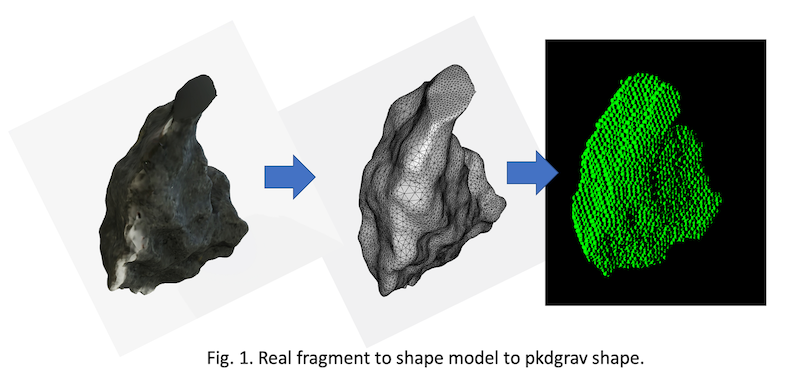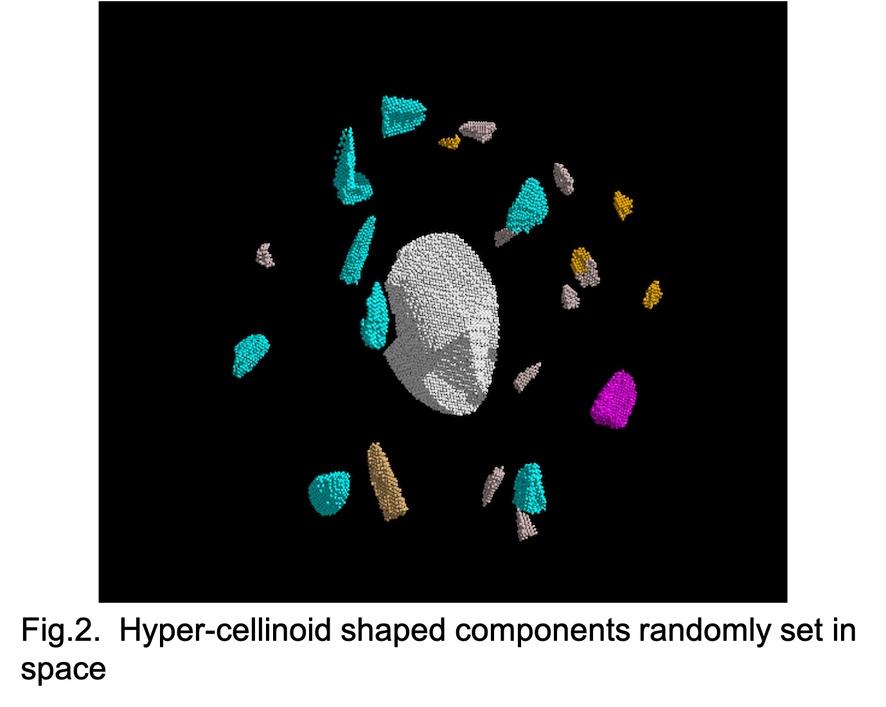Modelling small body gravitational aggregates by components with realistic shapes in the frame of the NEOMAPP project
- 1Instituto de Física Aplicada a las Ciencias y las Tecnologías. Universidad de Alicante. Sant Vicent del Raspeig, Spain (acb@ua.es)
- 2Departamento de Física, Ingeniería de Sistemas y Teoría de la Señal. Universidad de Alicante. Sant Vicent del Raspeig, Spain (acb@ua.es)
Introduction
The internal structure of asteroids and comets is fundamentally unknown due to difficulties in sounding their interiors. The measurements carried on by space probes and the observations of binary asteroids (optical and radar) have allowed acceptable estimates of the masses of a few asteroids. Estimates of their bulk densities are derived from their size and shape models. Such bulk densities are usually smaller than the values corresponding to typical densities of meteorites with compositions matching spectroscopical observations of the surfaces of those asteroids [1]. The interpretation of such low bulk densities is that part of the volume inside those objects is occupied by voids. Global structures with void space between coherent components qualify as gravitational aggregates (also, “rubble-piles”).
The origin of such bodies is clearly related to former catastrophic or gradual [2] disruption. Moreover, numerical simulations of the collisional evolution of the asteroid belt predict that most of the bodies between some hundreds of meters and about 100 km should be gravitational aggregates [3]. The situation is a little fuzzier in the case of comets.
The study of the interior structure of small bodies is gaining importance in planetary science as it may reveal relevant information about formation processes of both single and binary bodies. Also, in the frame of planetary defence strategy, the knowledge of internal structure of potentially hazardous asteroids turns out to be crucial to plan space missions to deflect them.
The DART (NASA) and Hera (ESA) space missions to binary Near Earth Asteroid (65803) Didymos are planned to check the capability of current technology to achieve such goal. Instrumentation aboard Hera and its cubesats shall reveal the actual structure of the target bodies, expected to be gravitational aggregates of about 780 m and 160 m respectively.
Many researchers have modelled gravitational aggregates in the past as collections of self-gravitating spheres and as components with ellipsoidal [4,5] or polyhedric shapes [6], in an attempt to have realistic description. Nevertheless, more realistic detail is needed if we wish to predict radar measurements by spacecraft and to calibrate specific instrumentation to perform the needed measurements. This problem is one of the tasks of the H2020 NEOMAPP project that is focusing on the internal structure of reference bodies like the Didymos system and Apophis.
Methodology.
In this work we go one step beyond the ellipsoidal or polyhedric improvement introduced in the last few years to the standard spherical approximation for the shapes of single components of gravitational aggregates. We make arbitrarily complex component shapes in two ways:
(a) By forming rigid solids with concave or convex surfaces utilizing up to 8 different geometrical shapes for each of the faces of irregular octahedra. We introduce increasing level of complexity by extending the concept of (1) super-ellipsoids [7] to (2) cellinoids [8], producing (3) super-cellinoids and to (4) each face of super-cellinoids (hyper-cellinoids).
(b) By using real fragments resulting from a set of laboratory shattering experiments performed at NASA-Ames facilities (Mountain Valley, CA, U.S.A.) in July 2013 [9]. We use photogrammetry technique to obtain shape models of tens of such fragments that will be utilized to create synthetic components of each gravitational aggregate.
In any of cases (a) and (b), we use the SSDEM PKDGRAV [10] code to make our aggregate components. (The process is summarized in Fig. 1.) For each randomly selected shape we make a group of spherical particles –the basic element of PKDGRAV- that are clumped together and forced to keep their mutual distance constant so they can be handled and behave like rigid bodies. Each such group has the desired shape with arbitrary resolution. We also draw at random the mass of each component from the experimental mass distributions.
Considering an arbitrary number (hundreds) of such irregular components and different mass spectra, we allow for their self-collapse by mutual gravitational interactions. Stochastic aggregate structures are formed and used as proxy to potential internal structures of real asteroids (e.g. Didymos/Dimorphos and Apophis).
References
[1] Carry, B. (2012) Plan. & Space Sci. 3, 98-118.
[2] Housen, K. (2009) P&SS, 57, 142-152.
[3] Campo Bagatin, A. et al. (2001) Icarus 149, 198-209
[4] Campo Bagatin, A. et al. (2018) Icarus 302, 343-359
[5] Campo Bagatin, A. et al. (2020) Icarus 339, 133603
[6] Ferrari, F. and tanga, P. (2020) Icarus 350, 113871
[7] Delaney, G.W. and Cleary, P.W (2010) EPL 89, 34002
[8] Lu, X. (2014) Earth, Moon & Pl. 112, 73-87
[9] Durda, D.D. et al. (2015) P&SS 107, 77-83
[10] Schwartz, S. et al. (2012) 14, 360-373


How to cite: Campo Bagatin, A., Liu, P.-Y., Parro, L., and Benavidez, P.: Modelling small body gravitational aggregates by components with realistic shapes in the frame of the NEOMAPP project, Europlanet Science Congress 2021, online, 13–24 Sep 2021, EPSC2021-663, https://doi.org/10.5194/epsc2021-663, 2021.

